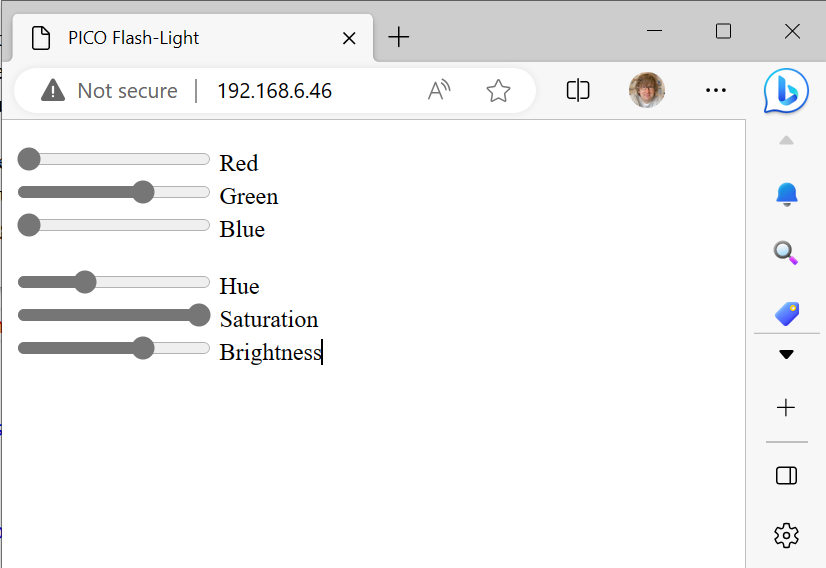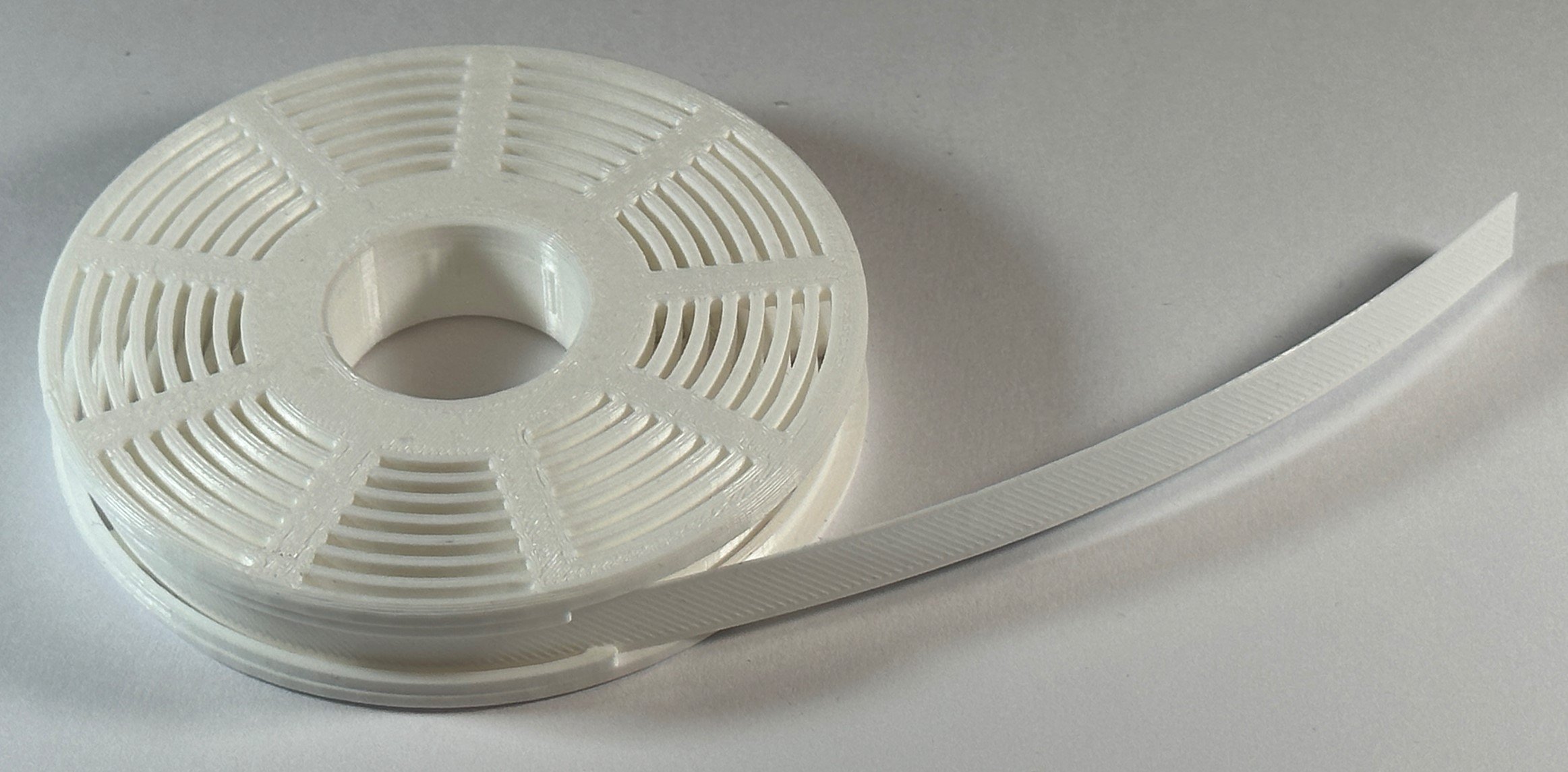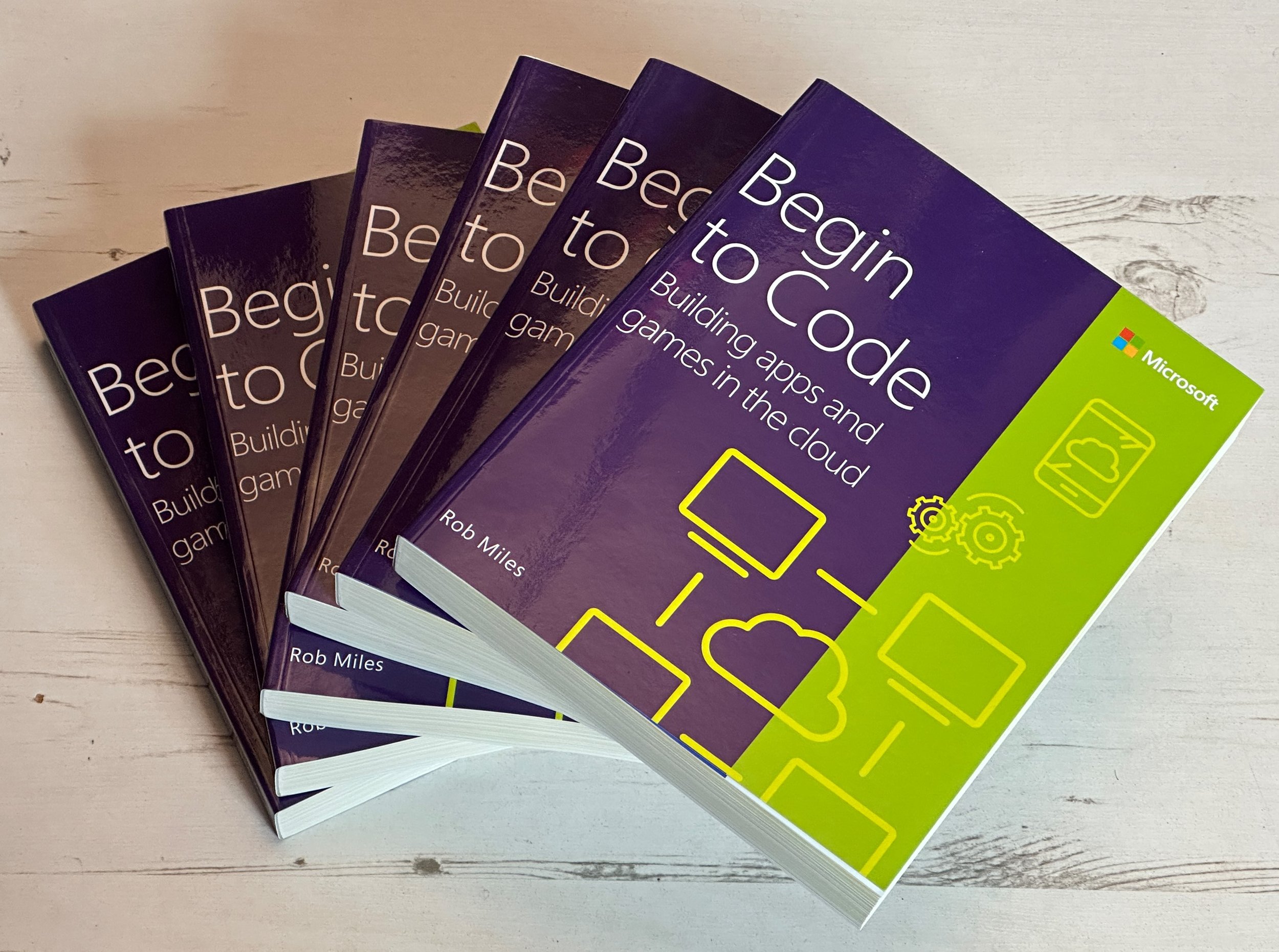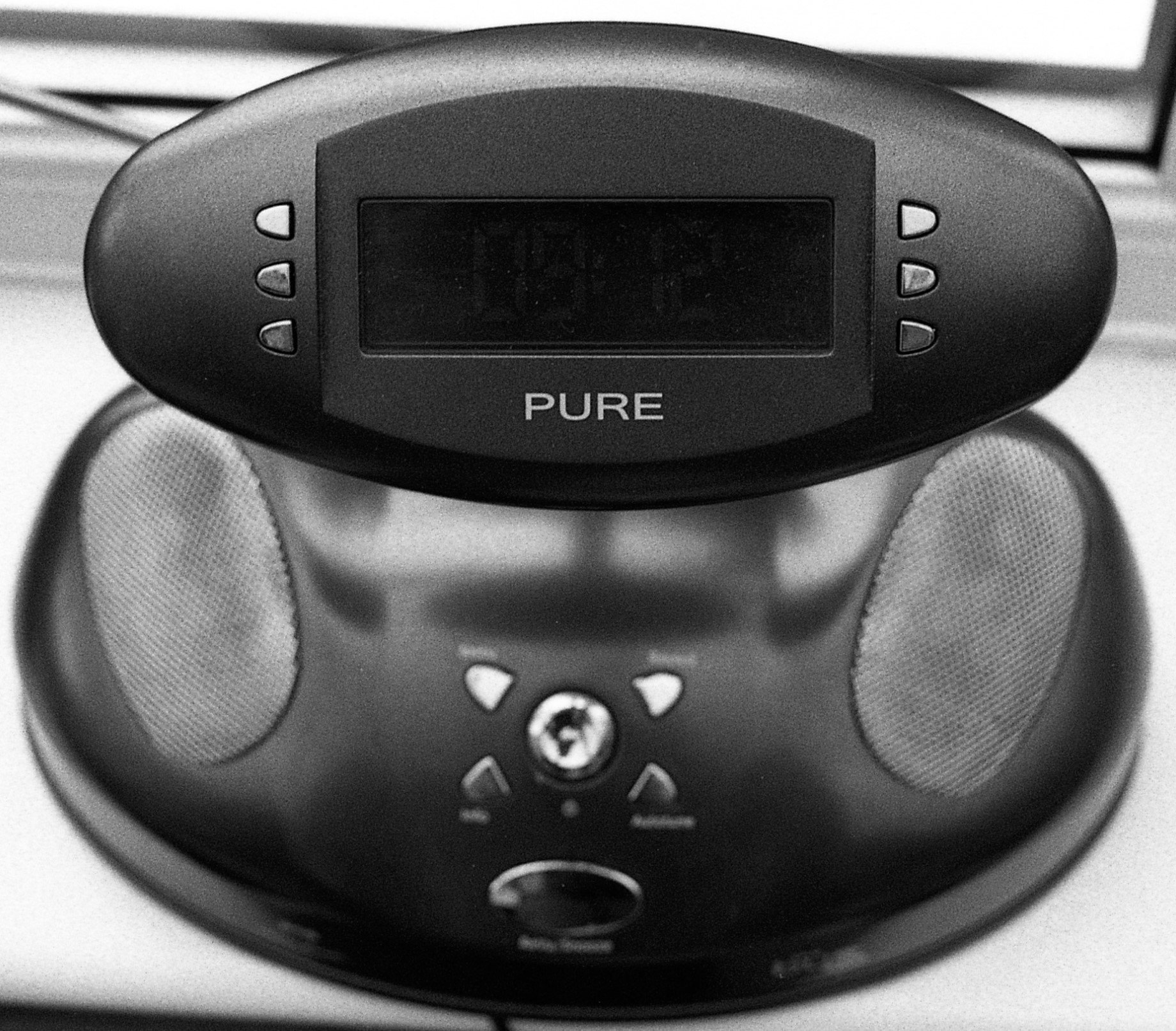Ready to travel
/Heading out on holiday soon. Spent ages putting cameras and lenses into a bag. Then a a few minutes lobbing clothes into a case…
Rob Miles on the web. Also available in Real Life (tm)
Heading out on holiday soon. Spent ages putting cameras and lenses into a bag. Then a a few minutes lobbing clothes into a case…

Next I need to add some style to the page
Yesterday I was building the web page used to set the colour of my remote controlled light. At first I went with three sliders to set the amount of red, green and blue (RGB) in the required colour. Then I decided that it might be use Hue, Saturation and Brightness (HSB) as a way of setting the colour. RGB is great, but if you want to change the overall brightness of a light it is a bit of a pain because you have to adjust all three sliders. This is much easier with HSB because you can adjust the brightness directly.
Adding the three new sliders to the web page was easy, but then I was faced with the problem of converting RGB to HSB and back. I wanted the display to be updated so that if you change the Hue the settings of the RGB values change to keep track. So I needed some conversion functions. I thought I’d ask ChatGPT to lend a hand. This is how I would expect the tool to be used. You’ve got a strong idea of what you want to do, experience with the tools and techniques you’re using and you just want the code.
ChatGPT was very happy to drop out JavaScript that it said would work. But it didn’t. Turns out that both Blue and Brightness begin with B. So all the single letter variables in the functions clashed with the parameters. I explained this problem and ChatGPT then dropped out some code that worked.
For me the interesting about this was that I found ChatGPT useful, but I needed to add my programming smarts to solve problems in the code that it produced. This gives me a tiny bit of hope for the future. It doesn’t look like I’m going to be completely replaced by ChatCPT. At least for now…

I’ve been waiting for ages for a reason to get this…
Very pleased to be able to report that I’ve been renewed as an MVP for another year. That makes it 20 years. I’ve spent nearly a third of my life as an MVP! Thanks very much Microsoft.
I got my self a parrot kit to celebrate. As you do.

This is the prototype light display
I’ve got the code for the remote controlled flash light just about working. It turns out to be a fairly simple matter to get a web site host running on a PICO and then get it to respond to incoming requests.

This is the interface to set the colour of the lights
I’m waiting for my super-bright led to arrive and then I’ll get the hardware built. Great fun. I’ll put all the code and designs onto GitHub when its finished.

We could have done with some clouds to make the sky more interesting..
Harrogate is a wonderful place. Not just because of Bettys, or the fantastic game shop but because of the amazing park that runs alongside the town. It has everything you might want for fun, especially if you are six years and six months old (or thereabouts). There’s a zipwire, crazy golf and somewhere that sells ice creams. Plus a padding pool if you’re feeling brave and have a towel with you. We had a very happy time there today. And we’ll be back.

There are a lot of different makes of trees in this picture

Nothing like having an Auto Thyristor in your flash gun
We were out and about at Cottingham Day this weekend. I took loads of pictures using my Minox B on very old film. That didn’t end well. Which is why I have no pictures of the event at all.
While we were out I picked up this flash gun on a second hand stall. I fancied having another flash gun, particularly for two quid. Of course it doesn’t work. To be honest, I wasn’t expecting it to. These things don’t age particularly well and Cobra is not a name known for quality and longevity. In fact I until I found the flash gun I didn’t think it had anything to do with photography at all.
I’m not bothered though. I plan to take out the internals and replace them with a PICO-W to create a remote controlled light. I can use the battery compartment, reflector and even the flash zoom lens and my plan is to keep it looking as much like the original as possible.

The big grey thing is the capacitor. Need to be careful with that bit as it might have residual charge in it.
I’ve got the flashgun to pieces. Turned out to be quite easy. The main part is held together with little metal clips. The circuit boards are almost exactly the same size as PICO, which has got to mean something. Next step is to work out how to fit some lights inside.

The pen and the dust on the camera are there for scale….
The Minox camera is very interesting. A while back; if you were caught carrying one you were assumed to be a spy. Because you probably were. The camera model above even made an appearance in a Bond film. In “On Her Majesty’s Secret Service” James is seen using one to take clandestine shots to a background of suitably tense music. The chain attached to the camera has little lumps in it (you can see them above) which correspond to distance settings on the super sharp lens. One of the lumps is pre-set to take perfectly focused pictures of A4 documents if you hold the camera that distance from the page. However, you can also use the camera to take pictures of less secret things and they come out surprisingly well. I’ve just added a Minox to my camera collection because I’ve always fancied one and I look great in a tuxedo.
Minox cameras first appeared in the 1930s and continued to be made up until just after the turn of the century. The Minox B (the one above) has a mechanical shutter and a little light meter you can use to set the exposure. Later ones had battery powered meters and shutters. It might look a very exclusive and expensive thing, but you can pick the cameras up quite cheaply because they were made over many years and there are lots about. Taking pictures is fun, you open and close the camera to wind the film on, and the shutter makes a very satisfying whirring sound when you press the tiny release button.
The camera takes tiny pictures onto film loaded into a cartridge that fits inside. My camera came with a roll of 20 year old film which I took out on Sunday to take some shots. Every single one came out completely black, which I hope is a comment on the age of the film and not on the camera or my technique. To process the pictures I printed a spiral film holder for use in my developing tank at home.

I also printed a piece of “test film” that I could use to practice loading the spiral
Minox film isn’t made any more. But there are folks out there who are refilling cartridges and selling them. I’ve ordered a bunch of films from here. They also do processing and scanning if you just want to live out your spy dreams and not spend any time in the darkroom.
I really like the camera. I find the whole design ethic and the way it is used very pleasing. You get the impression that the designer (a chap with the wonderful name of Walter Zapp) thought extremely hard about the best way of doing everything when he set out to make it. I know that the pictures it makes will not be super high quality (even when I manage to get some that come out) and I’ll have to set the exposure and focus myself. But that adds to the appeal to me. The shots will be plenty good enough for small prints and screen viewing. There is a huge range of accessories available, including an awesome home developing tank and a lovely little tripod.
If you like owning devices that are just nice to have around, actually do something and have a properly interesting history you should try to find a way to get yourself a Minox. If you shop around it won’t cost you much more than a triple A video game and I think you’ll find it very pleasing. One tip if you do decide to splash out: the selenium light meters in the B model degrade, particularly if the camera has spent a lot of time in the light. So if you are making a purchase you should make sure that you have a working one.

If you use both left handed and right handed keyboards at the same time you can channel your inner Rick Wakeman….
Issue 68 of HackSpace magazine is now out. On page 70 you can find my article that tells you how to create a Bluetooth connected chord keyboard using a PICO-W. There are lots of other great articles too. Well worth a read.
This is the most important rule for anyone with a 3D printer.
Never start to think of your 3D printer as an appliance.
My printer has been behaving very well of late. So well that I’ve started thinking it is something I can switch on and it will just work. Silly me. This morning I started a print and it promptly embedded the print head in the bed - necessitating a bunch of re-alignment and fiddling to get it back working again. Lesson learned.

I’ve forgotten how to turn it into a proper calculator…
While I was clearing a path for the plumber in our untidy garage I came across the above. I used to keep it in my office at work, in case anyone ever asked if I had a calculator they could borrow. It looks completely normal until you try to use it to do sums, at which point it displays one of a range of different insults. Snag is that in the days of spreadsheets and smartphones nobody ever asked to use it..
I’m selling stuff on eBay to fund my camera habit. The rule is that if I haven’t touched the device for a year it is fair game for sale. I guess the same rule will kick in when I’ve had the cameras I’m buying for a year or so……
Somebody has bought one of my music machines. So I carefully packed the device up in a box, stuck the labels on it and headed for the Post Office. To be told the box was too big for the service I wanted to use. The limit is 60cm. My box was 61. So, anyone out and about in our neighbourhood this lunchtime will have seen a tall, cross chap walking around with a large parcel muttering under his breath.
Of course, like most of my problems, it’s all down to my laziness. Rather than make the box fit the size of the thing being posted I instead used one which was too big and filled the space with packing material. I called this the “Amazon approach”. And laziness part 2 - not checking the maximum package size - guaranteed that I was going to be making multiple trips to the Post Office.
The solution was brutal and quick. I hacked the end off the box, cut out a chunk of cardboard and stuck it back on again. Size now down to 56cm. The box is now on its way, and I’ve got enough to pay for the cameras I shouldn’t have bought…..
The boiler is fixed. Wahay! Hot showers all round. The plumber came round and discovered a blockage in a drain pipe. The fix was a lot cheaper than I expected. So I’ve bought another camera to celebrate…..
No hot water this morning. Nothing says “welcome to the new day” like a cold shower. The boiler is showing a fault code, which in a way is a good thing for me because it means the problem is now out of my hands. And probably not my fault. Although it might of course be very expensive.
We called the plumber and he came round this afternoon, took one look at the huge mess in the garage and told us that he couldn’t really do anything because he needed to be able to get close to the patient without having to hack his way through heaps of stuff. Fair comment. I’ve spent the afternoon clearing a path and sauntering down memory lane. He’s coming back tomorrow.

This was not taken by mistake
I went into a camera shop today and didn’t come out with a camera. Mind you, there was a very tempting lens on sale……

If I had known I was going to do this I would have worn smarter shoes
My move into retro photography has allowed me to discover another joy of that genre. The foot photograph. This is when you set the camera off by mistake and, for some reason only known to the mystical universe, it always takes a picture of your foot.

Apparently they’ve cleaned the windows on Hepworth’s Arcade.
We went up town today. Not the best of moves as it turned out, what with one of the main roads being totally shut. We spent a lot longer in the car that we expected. I’d taken one of my film cameras and I was looking forward to taking some “proper” pictures with it. Thing is, the picture above wasn’t taken with a proper camera. It was taken with the phone. And I’m really, really pleased with it. The overall quality is excellent and the way that the people and items in it just arranged themselves in front of me was lovely. I would have had to work quite hard with a proper camera to get this result.

Mamiya 645 camera on Kentmere film developed in Rodinol
The picture above was taken on a medium format camera. I suppose a phone could have produced a result as good, but I’m pleased with it too.

Groverner Club
I’m adding “over the air” updates to my Connected Little Boxes. I’ve had the button on the device management form for a year or two. Over the last week I’ve been putting some code behind it. Over the air updates are magical. You can ask the device to download and install a new version of its firmware. On the surface it is quite easy to do. Except if, like me, you have a solution that uses nearly all the memory in the device. I’ve come up with a solution. When an update is required the device boots into a special “update” mode where the only element running is the code fetching the new firmware from the server. It is nearly working. Rather exciting.

Well, that’s the christmas presents problem solved for this year….
Six printed copies of my latest book arrived in the post today. Very nice. I’ve had a quick look and not found anything wrong yet - which is rather nice.

I took this while I was testing the olympus. Still works very well.
Found a bug today in the code that manages the “friendly names” of Connected Little Boxes. I let the user add a friendly name to a device so they can call it “Downstairs light” rather than “CLB-12d7ef”. I’ve added handling for the situation where they try to add a device with the same name as an existing one (I used the same method as Windows file explorer). If you try to use an existing file it adds a number on the end. The second version of “fred” is called “fred(1)”.My technique with bugs is to write a nice long description of what happens and how to fix it. I find that this gives my brain a bit of time to catch up and think it through. This is my description of the error and how I fixed it.
When you save the edits for an existing device it creates a new friendly name for it because it discovers that the old friendly name already exists – which of course it does. The current behaviour works fine for adding a new device (a new name is what you want), but breaks updating an existing device.
Fixed it by passing the original friendly name back to the device edit Post handler. This can then check if the friendly name has been edited and add generation information if it has. If you try to make a name with your own generation, for example create a name called “fred(1)” where “fred(1)” already exists the program will make a new name of “fred(1)(1)” which is acceptable. If you want to get “fred(n)” where n is the next available fred generation you just leave off the number and brackets. I pondered whether to remove the generation value from a clashing name so that it would automatically pick the next number in the sequence, but this could result in confusing number changes where someone saves “fred(6)” and ends up with “fred(10”.
If you are faced with an error I strongly suggest that you do something like this and then add it to your daily journal so that you can go back and refer to it. If you don’t keep a daily journal I strongly suggest that you start one.

the radio still mostly works - which makes it something of a rarity apparently
It turns out that developing film is an art. Who knew? It’s a chemical process. The parts of the film that were exposed to light react with the developer to make particles of silver which end up on the negative as dark spots called “grain”. The more light, the darker the spot. Hower, the amount of developer you use and the time you leave the film in it are important, as is how you agitate the film to put fresh developer into contact with the film surface.
And then there’s acutance. This happens along the borders between bright and dark areas on the image being developed. The developer in an exposed area is “used up” as it reacts to make the silver film grains.. This causes developer to migrate over from an unexposed part, resulting in the enhancement of edges in the finished picture and making brighter areas “pop” out of the image. The amount of acutance you get depends on how much agitation you give the film. There’s also “stand development” where you just leave the film standing in the developer for an hour or so.
And then there’s how much you dilute the developer and the number of minutes you leave the film in it, as well as the exposure you used when you took the shot. I’ve been working with 1+50 dilutions of Rodinol developer. This seems to work quite well. It also makes developing film very cheap. I’ve got a bottle of developer and think it might last a long time.
If you want to get into this (and it is rather fun) I can recommend the Massive Dev website for development times (there’s also a really good app) and this video.
Rob Miles is technology author and educator who spent many years as a lecturer in Computer Science at the University of Hull. He is also a Microsoft Developer Technologies MVP. He is into technology, teaching and photography. He is the author of the World Famous C# Yellow Book and almost as handsome as he thinks he is.